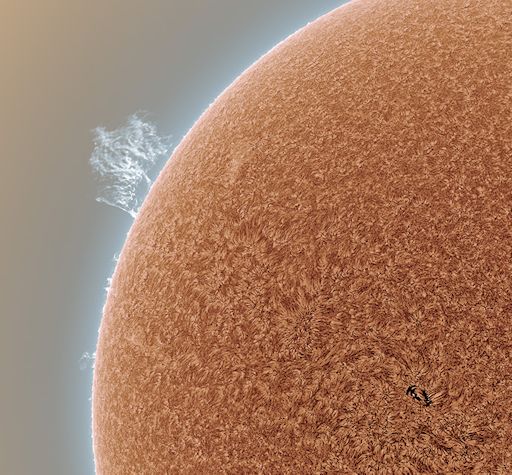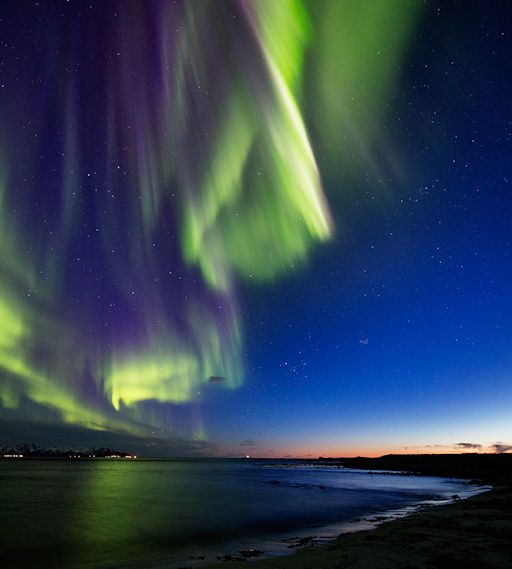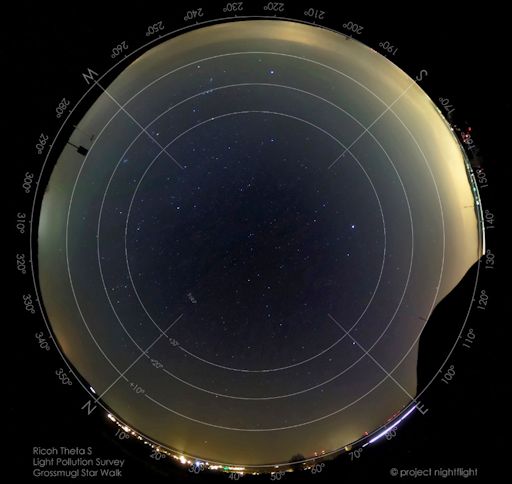Marianne's Heaven On Earth Aurora Chaser Tours Chasethelighttours.co.uk invites you to join them in their quest to find and photograph the Aurora Borealis. Experience the winter wonderland in the Tromsø Area. | | | ANOTHER STREAM OF SOLAR WIND IS COMING: Geomagnetic activity is subsiding as Earth exits a solar wind stream that hit our planet's magnetic field on April 2nd. The quiet might not last long, however, because another stream of solar wind is coming. Estimated time of arrival: April 5th. NOAA forecasters say there is a a 55% chance of G1-class geomagnetic storms on Tuesday. Once again, Arctic sky watchers are favored for auroras. Aurora alerts: text or voice GIANT SOLAR PROMINENCES: Solar activity takes many forms. Researchers often focus their attention on sunspots, counting dark cores that pepper the solar disk as a metric of the solar cycle. However, sunspots aren't the only manifestation of unrest. This week, sunspots are outnumbered by prominences. Alan Friedman photographed this specimen from his backyard observatory in Buffalo, New York: 
"A short break in the clouds and spring snow showers allowed a peek at the sun today," says Friedman. "It was quite a view with two large prominences (and many smaller ones) at the edge of the disk." Friedman's full-disk image is a must-see. Prominences are clouds of plasma held above the sun's surface by unstable magnetic fields. The one pictured above is called a "hedgerow prominence" because of its resemblance to the shrub-y border of a terrestrial road or yard. NASA and Japanese space telescopes have taken high resolution images of similar prominences and seen some amazing things such as (1) tadpole-shaped plumes that float up from the base of the prominence; (2) narrow streams of plasma that descend from the top like waterfalls; and (3) swirls and vortices that resemble van Gogh's Starry Night. This is a good week to see these structures in action. If you have a solar telescope, take a look! Realtime Space Weather Photo Gallery TWILIGHT VS. NORTHERN LIGHTS: Soon, the season for auroras around the Arctic Circle will come to an end. The auroras aren't leaving. They're just losing a battle for visibility with the approaching Midnight Sun. On April 3rd, Frank Olsen photographed the competition over Norway's Andøya Island: 
"Nothing beats the colors of the auroras when they appear side-by-side with the sunset," says Olsen. "Aurora season is definitely going out with a bang." As April unfolds, the Midnight Sun will eventually overwhelm auroras around the Arctic Circle. For now, though, the competition seems evenly matched. More twilight shots are possible in the nights ahead--especially on April 5th when another solar wind stream is expected to hit Earth's magnetic field. Monitor the gallery for sightings: Realtime Aurora Photo Gallery SPHERICAL ASTRONOMY CAMERA: Astrophotographers are increasingly impressed by a new camera on the market. It's the Ricoh Theta S, and it can take spherical images and videos under a wide range of astronomical conditions. The students of Earth to Sky Calculus have used it to photograph the edge of space from a freezing helium balloon flying 117,000 feet above Earth, as well as a total eclipse of the sun from a balmy beach only a few feet above sea level in Indonesia. Last week in Europe, photographers Karoline Mrazek and Erwin Matys found a new use for the Ricoh Theta S. "It makes a great survey instrument for light pollution," they say. Click on the image for a 360-degree view: 
"We did an exposure at Star Meadow, the endpoint of the Grossmugl Star Walk in Austria," they explain. "It shows that the environment is 'clouded' by light pollution as much as 20 degrees above the horizon. This will help us plan future observing sessions at this otherwise dark-sky site." Mrazek and Matys are founding members of the astrophotography group project nightflight. They've been testing the Ricoh Theta S in many settings for night-sky photography. Their complete report on spherical astrophotography is highly recomended. Read it here. Realtime Spaceweather Photo Gallery Realtime Comet Photo Gallery
Solar Eclipse Photo Gallery
Every night, a network of NASA all-sky cameras scans the skies above the United States for meteoritic fireballs. Automated software maintained by NASA's Meteoroid Environment Office calculates their orbits, velocity, penetration depth in Earth's atmosphere and many other characteristics. Daily results are presented here on Spaceweather.com. On Apr. 4, 2016, the network reported 5 fireballs.
(5 sporadics)  In this diagram of the inner solar system, all of the fireball orbits intersect at a single point--Earth. The orbits are color-coded by velocity, from slow (red) to fast (blue). [Larger image] [movies] Potentially Hazardous Asteroids ( PHAs) are space rocks larger than approximately 100m that can come closer to Earth than 0.05 AU. None of the known PHAs is on a collision course with our planet, although astronomers are finding new ones all the time. On April 4, 2016 there were potentially hazardous asteroids.  | Notes: LD means "Lunar Distance." 1 LD = 384,401 km, the distance between Earth and the Moon. 1 LD also equals 0.00256 AU. MAG is the visual magnitude of the asteroid on the date of closest approach. | | Cosmic Rays in the Atmosphere | | Situation Report -- Oct. 30, 2015 | Stratospheric Radiation (+37o N) | | Cosmic ray levels are elevated (+6.1% above the Space Age median). The trend is flat. Cosmic ray levels have increased +0% in the past month. | | Sept. 06: 4.14 uSv/hr (414 uRad/hr) | | Sept. 12: 4.09 uSv/hr (409 uRad/hr) | | Sept. 23: 4.12 uSv/hr (412 uRad/hr) | | Sept. 25: 4.16 uSv/hr (416 uRad/hr) | | Sept. 27: 4.13 uSv/hr (413 uRad/hr) | | Oct. 11: 4.02 uSv/hr (402 uRad/hr) | | Oct. 22: 4.11 uSv/hr (411 uRad/hr) | These measurements are based on regular space weather balloon flights: learn more. Approximately once a week, Spaceweather.com and the students of Earth to Sky Calculus fly "space weather balloons" to the stratosphere over California. These balloons are equipped with radiation sensors that detect cosmic rays, a surprisingly "down to Earth" form of space weather. Cosmic rays can seed clouds, trigger lightning, and penetrate commercial airplanes. Our measurements show that someone flying back and forth across the continental USA, just once, can absorb as much ionizing radiation as 2 to 5 dental X-rays. For example, here is the data from a flight on Oct. 22, 2015: 
Radiation levels peak at the entrance to the stratosphere in a broad region called the "Pfotzer Maximum." This peak is named after physicist George Pfotzer who discovered it using balloons and Geiger tubes in the 1930s. Radiation levels there are more than 80x sea level. Note that the bottom of the Pfotzer Maximim is near 55,000 ft. This means that some high-flying aircraft are not far from the zone of maximum radiation. Indeed, according to the Oct 22th measurements, a plane flying at 45,000 feet is exposed to 2.79 uSv/hr. At that rate, a passenger would absorb about one dental X-ray's worth of radiation in about 5 hours. The radiation sensors onboard our helium balloons detect X-rays and gamma-rays in the energy range 10 keV to 20 MeV. These energies span the range of medical X-ray machines and airport security scanners. | | The official U.S. government space weather bureau | | | The first place to look for information about sundogs, pillars, rainbows and related phenomena. | | | Researchers call it a "Hubble for the sun." SDO is the most advanced solar observatory ever. | | | 3D views of the sun from NASA's Solar and Terrestrial Relations Observatory | | | Realtime and archival images of the Sun from SOHO. | | | from the NOAA Space Environment Center | | | the underlying science of space weather | | 
